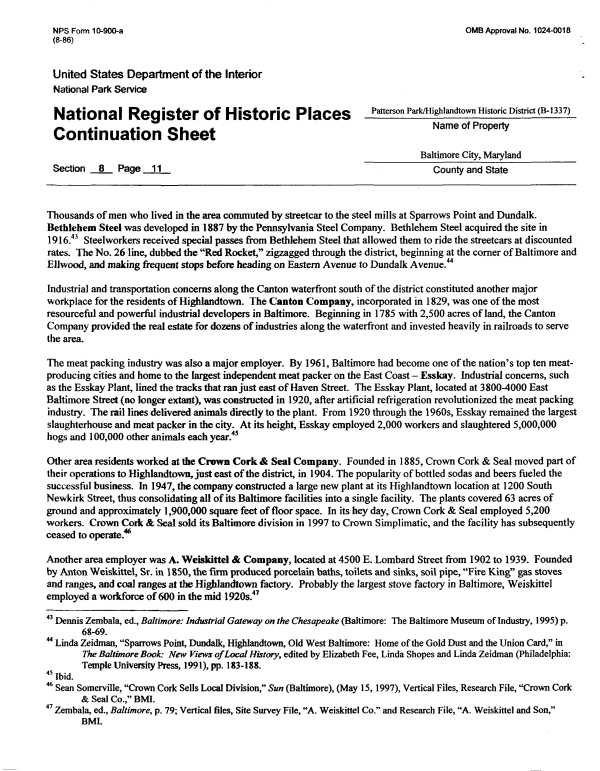 |
||||
|
DEPARTMENT OF HOUSING AND COMMUNITY DEVELOPMENT, MARYLAND HISTORICAL TRUST (Historic Sites Survey) var.d. MSA SE16-3 Image No: se16-3-0106 Enlarge and print image (82K) |
 |
||||
|
DEPARTMENT OF HOUSING AND COMMUNITY DEVELOPMENT, MARYLAND HISTORICAL TRUST (Historic Sites Survey) var.d. MSA SE16-3 Image No: se16-3-0106 Enlarge and print image (82K) |
| NPS Form 1 0-900-a OMB Approval No. 1 024-001 8 (8-86) United States Department of the Interior National Park Service person National Register of Historic Places n .. *. ęk. A Name of Property Continuation Sheet Baltimore City, Maryland Section 8 Page 11 County and State Thousands of men who lived in the area commuted by streetcar to the steel mills at Sparrows Point and Dundalk. Bethlehem Steel was developed in 1887 by the Pennsylvania Steel Company. Bethlehem Steel acquired the site in 1916.43 Steelworkers received special passes from Bethlehem Steel that allowed them to ride the streetcars at discounted rates. The No. 26 line, dubbed the "Red Rocket," zigzagged through the district, beginning at the comer of Baltimore and Ellwood, and making frequent stops before heading on Eastern Avenue to Dundalk Avenue.44 Industrial and transportation concerns along the Canton waterfront south of the district constituted another major workplace for the residents of Highlandtown. The Canton Company, incorporated in 1829, was one of the most resourceful and powerful industrial developers in Baltimore. Beginning in 1785 with 2,500 acres of land, the Canton Company provided the real estate for dozens of industries along the waterfront and invested heavily in railroads to serve the area. The meat packing industry was also a major employer. By 1961, Baltimore had become one of the nation's top ten meat-producing cities and home to the largest independent meat packer on the East Coast - Esskay. Industrial concerns, such as the Esskay Plant, lined the tracks that ran just east of Haven Street. The Esskay Plant, located at 3800-4000 East Baltimore Street (no longer extant), was constructed in 1920, after artificial refrigeration revolutionized the meat packing industry. The rail lines delivered animals directly to the plant. From 1920 through the 1960s, Esskay remained the largest slaughterhouse and meat packer in the city. At its height, Esskay employed 2,000 workers and slaughtered 5,000,000 hogs and 100,000 other animals each year.45 Other area residents worked at the Crown Cork & Seal Company. Founded in 1885, Crown Cork & Seal moved part of their operations to Highlandtown, just east of the district, in 1904. The popularity of bottled sodas and beers fueled the successful business. In 1947, the company constructed a large new plant at its Highlandtown location at 1200 South Newkirk Street, thus consolidating all of its Baltimore facilities into a single facility. The plants covered 63 acres of ground and approximately 1,900,000 square feet of floor space. In its hey day, Crown Cork & Seal employed 5,200 workers. Crown Cork & Seal sold its Baltimore division in 1997 to Crown Simplimatic, and the facility has subsequently ceased to operate.46 Another area employer was A. Weiskittel & Company, located at 4500 E. Lombard Street from 1902 to 1939. Founded by Anton Weiskittel, Sr. in 1850, the firm produced porcelain baths, toilets and sinks, soil pipe, "Fire King" gas stoves and ranges, and coal ranges at the Highlandtown factory. Probably the largest stove factory in Baltimore, Weiskittel employed a workforce of 600 in the mid 1920s.47 43 Dennis Zembala, ed., Baltimore: Industrial Gateway on the Chesapeake (Baltimore: The Baltimore Museum of Industry, 1995) p. 68-69. 44 Linda Zeidman, "Sparrows Point, Dundalk, Highlandtown, Old West Baltimore: Home of the Gold Dust and the Union Card," in The Baltimore Book: New Views of Local History, edited by Elizabeth Fee, Linda Shopes and Linda Zeidman (Philadelphia: Temple University Press, 1991), pp. 183-188. 45 Ibid. 46 Scan Somerville, "Crown Cork Sells Local Division," Sun (Baltimore), (May 15, 1997), Vertical Files, Research File, "Crown Cork & Seal Co.," BMI. 47 Zembala, ed., Baltimore, p. 79; Vertical files, Site Survey File, "A. Weiskittel Co." and Research File, "A. Weiskittel and Son," BMI. |